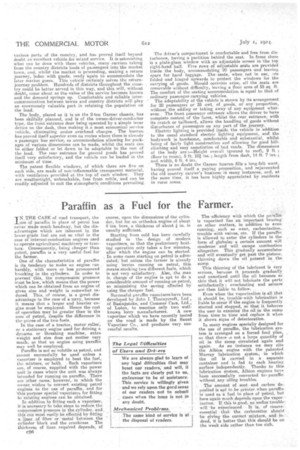Paraffin as a Fuel for the Farmer.
Page 14

If you've noticed an error in this article please click here to report it so we can fix it.
THE CASE of road transport, the osis of paraffin in place of petrol has never triaclemuds headway, but the disadvantages which are inherent in the lower-grade fuel are not so vital in the case of internal-combustion engines used to operate agricultural machinery or tractors. Consequently, being cheaper than petrol, paraffin is a very useful fuel for the farmer.
One of the characteristics of paraffin is its tendency to snake an engine run harshly, with more or less pronounced knocking in the cylinders. In order to preVent this, the compressionpressure must below, which means that the power which can b obtained from an engine of given size and weight is somewhat reduced. This, of. course, is a -great disadvantage in the cased f a lorry, because it means that a larger and heavier engine must be employed. Hence the cost of operation may, he greater than in the case of petrol, despite the difference in the prices of the two feels.
In the case of a tractor, motor roller, or a stationary engine used for driving a dynamo or threshing machine, extra weight and size does not matter very much, so that an engine using paraffin may well be employed.
Paraffin is not so volatile as petrol, and cannot successfully be used unless a vaporizer is employed to heat the fuel, the mixture, or both. Such vaporizers are, of course, supplied With the power Unit in cases where the unit was always intended for running on paraffin. There are .other cases, however, in which the owner, wishes to convert existing petrol engines to the use of paraffin, and for this purpose special-vaporizers for fitting to existing engines can be obtained.
In addition to fitting such a vaporizer, it is necessary to take steps to reduce the compression pl'essure in the cylinder, and,
this can Most easily-We effected by fitting a liner of fibre or -Metal between the cylinderblock and the crankcase. The thickness of liner required depends, of
n26 course, upon the dimensions of the cylinder, hut for an orthodox engine of about 4 ins, bore, a thickness of about a in. is usually sufficient.
Starting from cold has been carefully studied in the design of modern vaporizers, 80 that the preliminary heating operation only takes a few minutes, after which the engine can be started. In some cases starting on petrol is advocated; but unless the farmer is already using lorries running on petrol, this means stocking two different fuels, which is tint very satisfactnry. Also, the man in charge of the engine is apt to do a considerable amount of running on petrol, so minimizing the saving effected by tssing the cheaperfuel.
Successful paraffin vaporizers have been developed by John I. Thornyeraft, Ltd , of Basingstoke, and Commer Cars, Ltd.; of Luton, to mention only two well known lorry manufacturers. A new vaporizer which we have recently tested on the road is made by the Saunt Vaporizer Co., and produces very successful results. The efficiency with which the paraffin is vaporized has an important bearing' on other matters, in addition to even running, such as wear, carbonization, trouble with valves, etc. If the paraffin is allowed to enter the cylinders in the form of globules a certain amount will condense and will escape combustion altogether. This gradually accumulates and will eventually get past the pistons, thinning down the ail 'present lli the sump. This thinning of the lubricant is very serious, because it proceeds gradually and unnoticed until the oil becomes so thin that it will not lubricate the parts: satisfactorily ; overheating and seizure are then liable to follow.
f1ven when the vaporization is all that it should be, trouble--with lubrication is liable to occur if the engine is frequently started and stopped, so that it behoves the user to examine the oil in the sump from time to time and replace it when it shows signs of deterioration.
In many engines specially designed for the use of paraffin, the lubrication system is arranged on a forced feed plan, „ so that there ,s not a large quantity of oil in the sump circulated again and
again. As an instance we may cite the Albion engine with the patented Murray lubrication system, in which the oil is °carried in a separate container and is fed to each bearing surface independently. Thanks to this lubrication system, Albion engines have been successfully converted to, paraffin
without any oiling troubles.
The amount of sootand carbon deposited is apt to he greater when paraffin is used as a fuel in place of petrol, but here again much depends upon the vapor-ization. If this is good, no undue troublewill be experienced. It is,of course: essential that the carburetter should he giving the correct -mixture, and hi. deed, it is better that this should-be on the weak side rather than too rich.














































